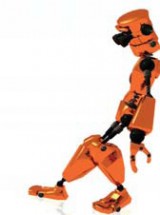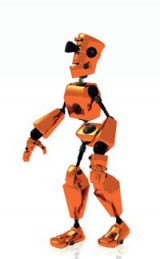Set children’s gears whirring with Marc Bowen’s exciting contexts for control technology...
 Control technology can push teachers out of their comfort zone, especially in upper KS2 where skills development becomes more complex. However, with an engaging context, children will be eager to use and adapt the technology for their own purposes. Combined with specific skills teaching, this will lead to some memorable lessons, which can be linked to many other areas of the curriculum.
Control technology can push teachers out of their comfort zone, especially in upper KS2 where skills development becomes more complex. However, with an engaging context, children will be eager to use and adapt the technology for their own purposes. Combined with specific skills teaching, this will lead to some memorable lessons, which can be linked to many other areas of the curriculum.
The context for this topic is that a band of robots, each with different capabilities, join together and use their unique skills to solve a series of problems – with the help of the talented techs in your classroom, of course. Care for the environment with Ecobot, chase through the city streets with a Carbot or build the Iron Man!
Due to the variety of control technology resources used by schools, these activities are as generic as possible, allowing teachers to adapt them to suit their own context. You may also want to incorporate well known robots from television and cinema to give your project a little extra personality.
What will children learn?
• How to experiment with a robot’s movements
• How to follow/enter a set of instructions to direct a robot
• How to edit instructions
• How to write a procedure
• How to use sensors to control a robot’s movements
Help rebuild the iron man
This activity works well as an introduction to the topic. It’s based on Ted Hughes’ The Iron Man, which may have already been used as a class book. If not, an extract could be shared with the children to set the scene of the damaged Iron Man lying on the beach.
Following this introduction, the children should be set the task of guiding a floor robot (e.g. a Roamer or Bee-Bot) across a beach scene to reach and retrieve each of the Iron Man’s component parts.
As part of a DT project, the children could design a cover for the floor robot to make it look like the Iron Man’s hand. A contour map of the beach could also be created, with a textured, sandy surface for the robot to travel across; the children entering instructions on route to adjust its progress.
On a larger scale, how about incorporating some drama into the topic? Ask the children to ‘set-design’ the classroom with fabrics and an assortment of objects collected from the beach. They can then role play the early stages of the novel and use this set-up as an environment for the floor robot to explore. The overall outcome could be to build a large scale model of the Iron Man in the classroom, using the parts children have located with the floor robot.

Journey through the solar system
‘After the sudden activation of the Iron Man he wanders the countryside, confused and dazed. Where should he go? What should he do?
On a distant planet, Carbot picks up a signal indicating that his old friend is still functioning on Earth but he is seriously damaged. The Iron Man is need of help and guidance before he provokes a bad reaction from the fearful humans.’
This scene-setter could be used to introduce the next control activity. It could equally be addressed through a literacy lesson - i.e. the children write the distress message that Carbot receives from the Iron Man.
Ask the children to create a large scale map of the solar system. They will use this to plan the journey that Carbot takes to reach Earth and help his friend. This route would need to be continuous, rather than adapted along the way as in the previous session. Therefore, children would need to plan out the entire set of instructions and then test them on the floor robot. If they hit a planet on route, they need to start again – revising their instructions. This could be further extended by the teacher adding obstacles to the map, such as asteroids or spacecraft, which must be avoided.
Draw a garden plan
Continuing to build on the context of the Iron Man’s activities on Earth, the children could be asked to consider the damage he may have caused to the countryside and people’s gardens. Introduce the character of Ecobot, a robot who loves looking after living things in the environment.
Explain that Ecobot has been set the task of repairing and rebuilding the damage to the landscape. This can be used as the context for using the floor robot to draw an image, using its pen attachment. Children need to devise a set of instructions that will direct Ecobot to draw a plan of a garden with planters, beds and pathways.
Equally, Ecobot could be asked to compile a catalogue of flowers; requiring groups of children to design their own flower head on paper and then create the instructions needed for the robot to draw this to a larger scale. This activity would also incorporate aspects of the numeracy curriculum, as the children may well need to use their knowledge of angles and degrees of turn within their procedure. Each group would then contribute their design(s) to the whole class catalogue.
Experiment with sensors
‘The Iron Man needs help to travel through a busy city as his eyes are damaged. Carbot is worried that innocent humans may be hurt or buildings damaged. He decides to call on Fixabot, as he is the most manoeuvrable robot friend they have and his sensors may be useful.’
This activity requires the children to use the built-in sensors available within many modern floor robots (such as the Probot or Lego Robotics equipment).
To begin with, a large scale city map could be made by the children as part of a mapping skills activity in geography, or as a form of story map in literacy. This could then be used as a track for the floor robot to negotiate using the sensor inputs. For example, the sensors could be used to instruct the robot to follow the light or dark lines in the centre of the road. At the same time, the robot could be programmed to reverse a set distance and turn a set angle each time its touch sensors encounter an obstacle, before continuing its route through the city
The robots’ journey through the city could even be extended into a written activity, where the children write newspaper reports on the amazing events, or a set of instructions for other robots to use. It might also be possible to use the activity as a basis for a narrative story, describing the robots’ adventures.

3 Ways to improve pupils’ ict skills…
• Extend your higher ability children – make them roving control experts who can help with troubleshooting and demonstration.
• Assign roles to each group to help organise control activities; technicians input the commands, test pilots run trials of commands and record results, mission controllers plan movements and procedures. Rotate the roles periodically to ensure holistic skills development.
• It’s easier to teach control skills to the whole class if the school has multiple floor robots, technical construction kit or site licensed software. Single items that can only be used by small groups will limit what you can achieve.
8 Ways To Get Your Class Drawing
Ace-Art-And-Design
If your marking doesn’t affect pupil progress - stop it!
Ace-Classroom-Support
